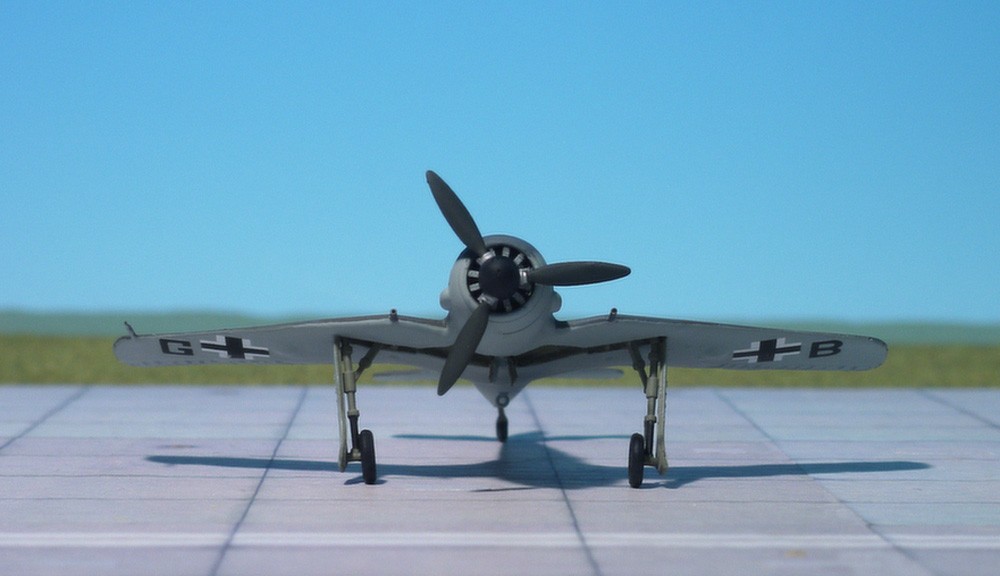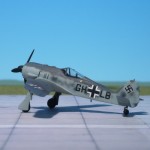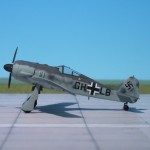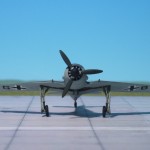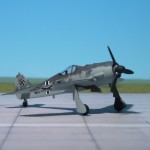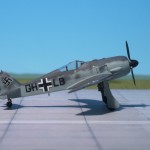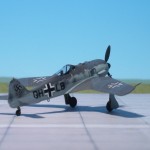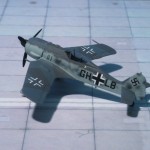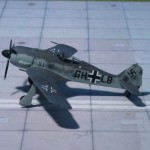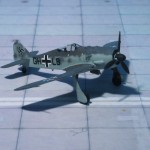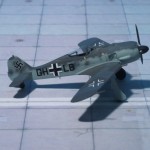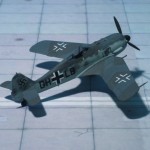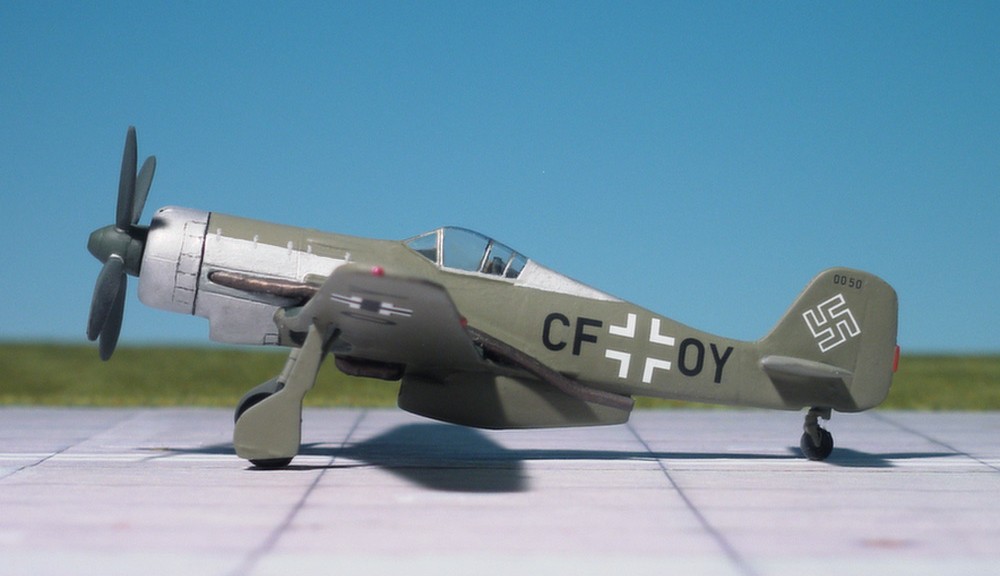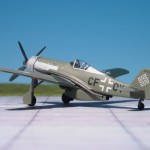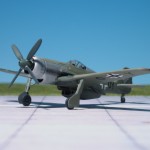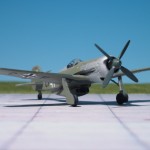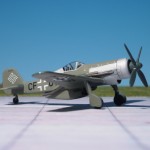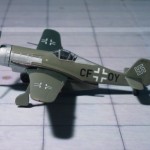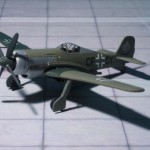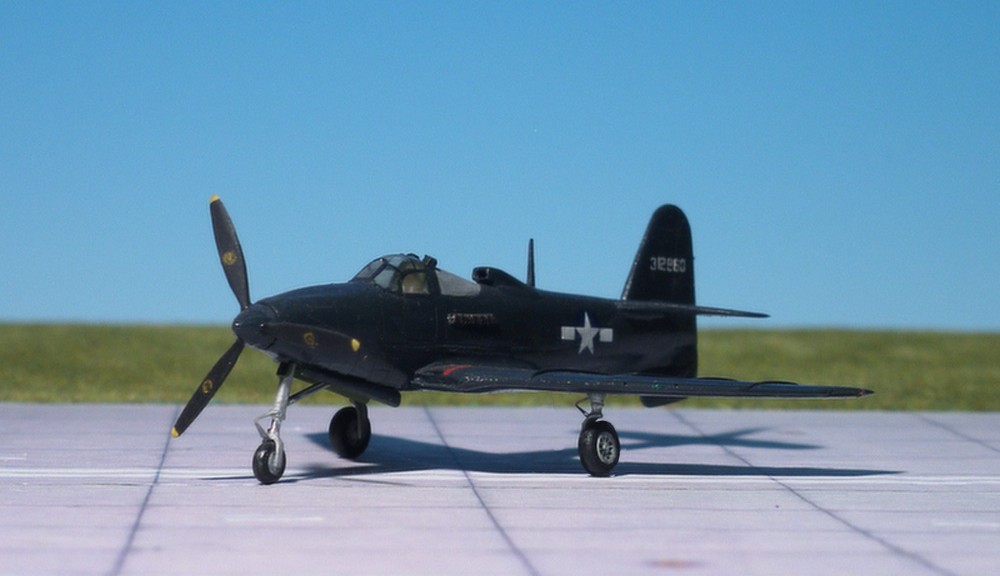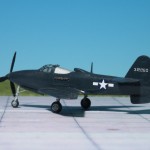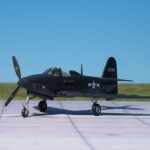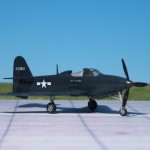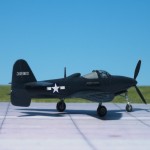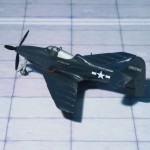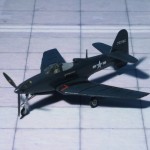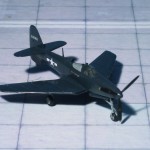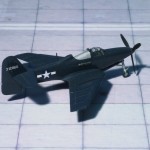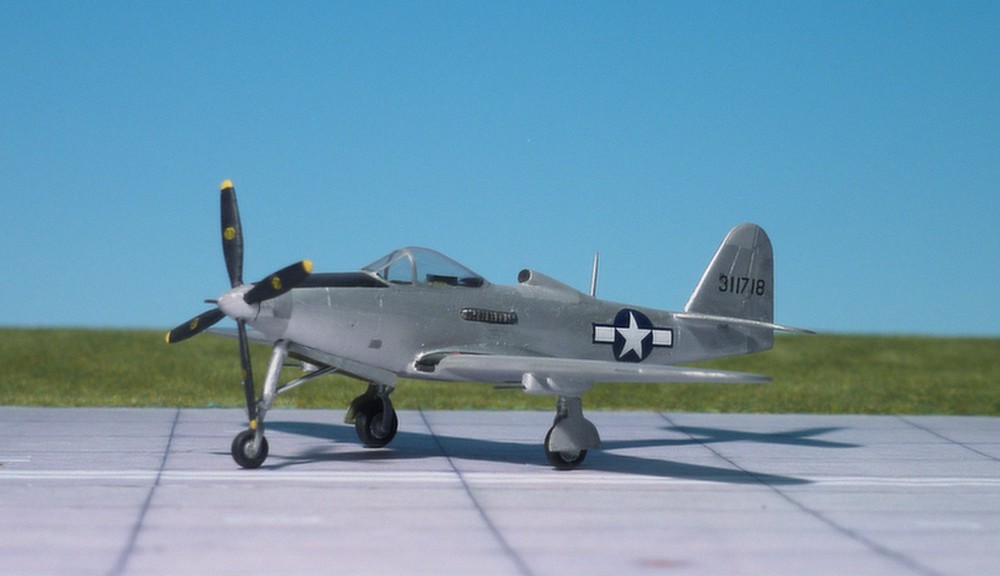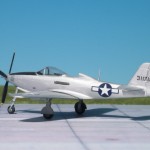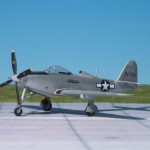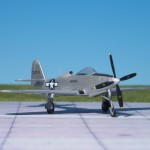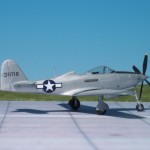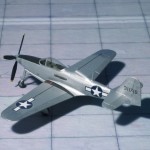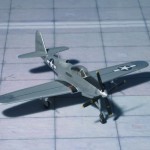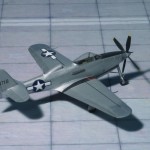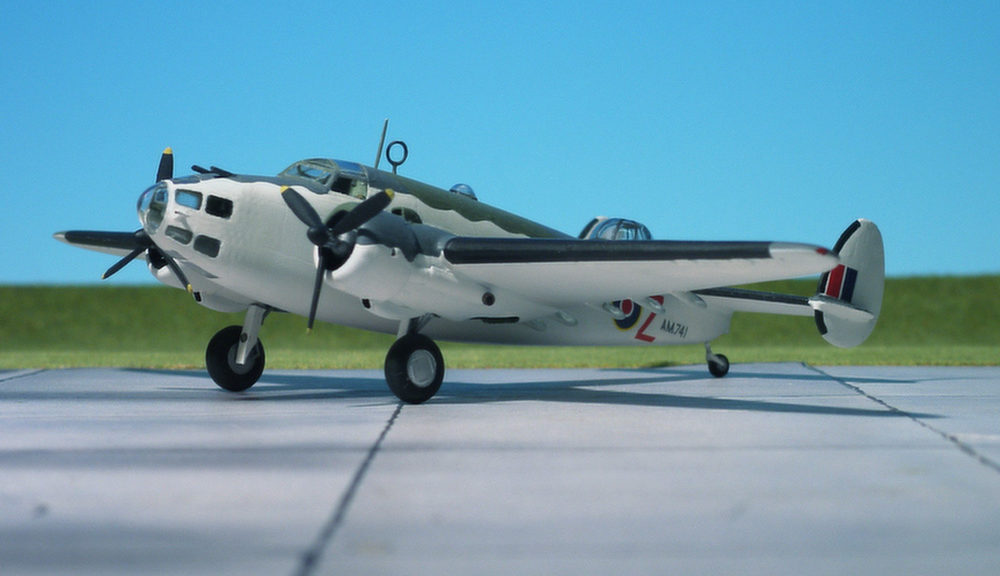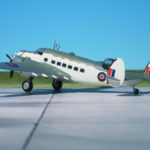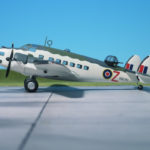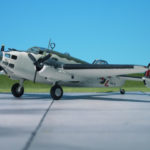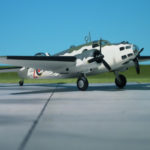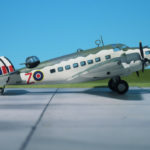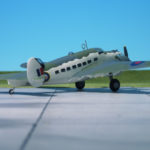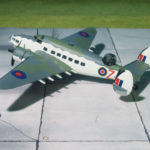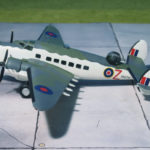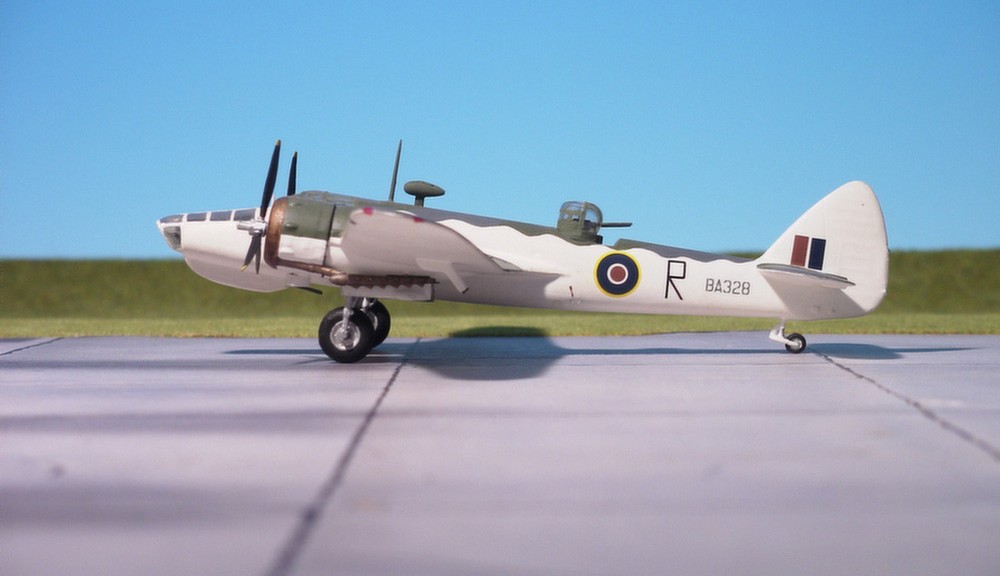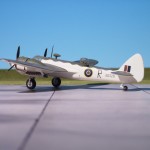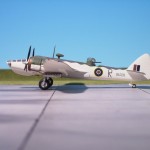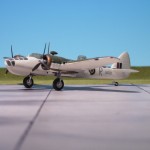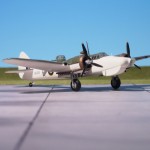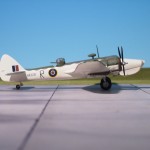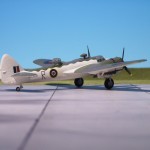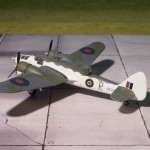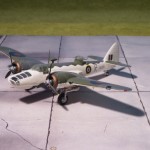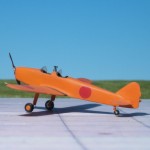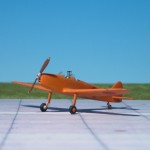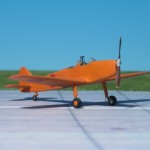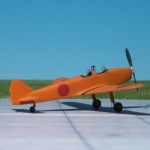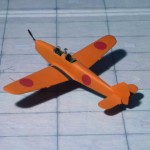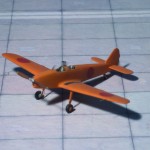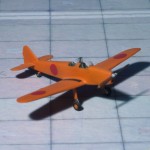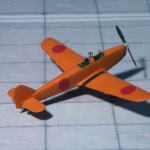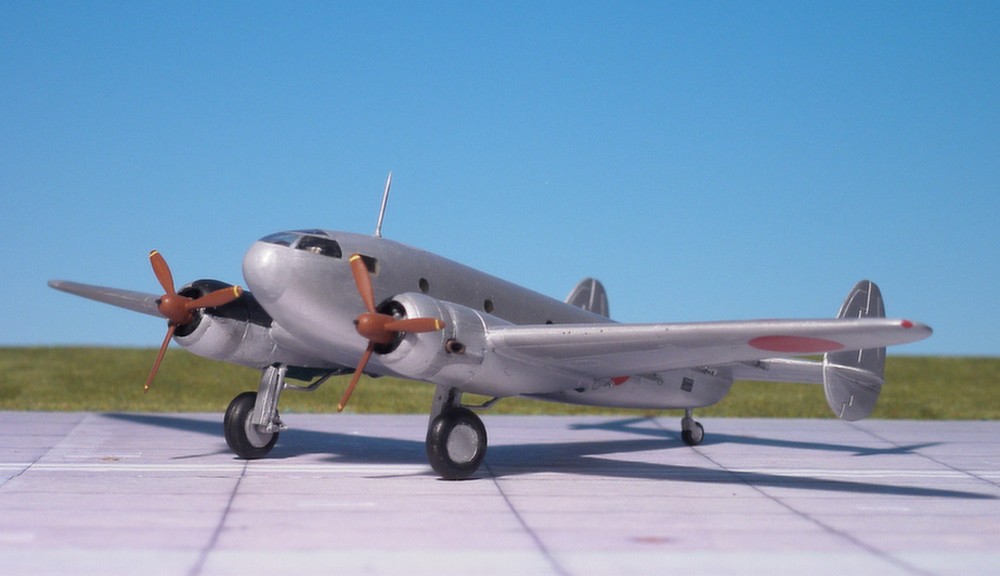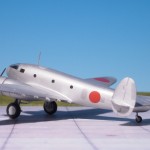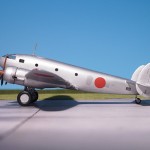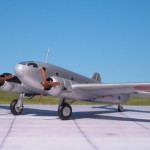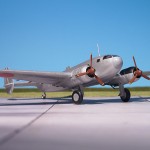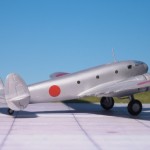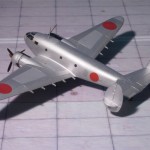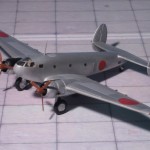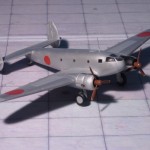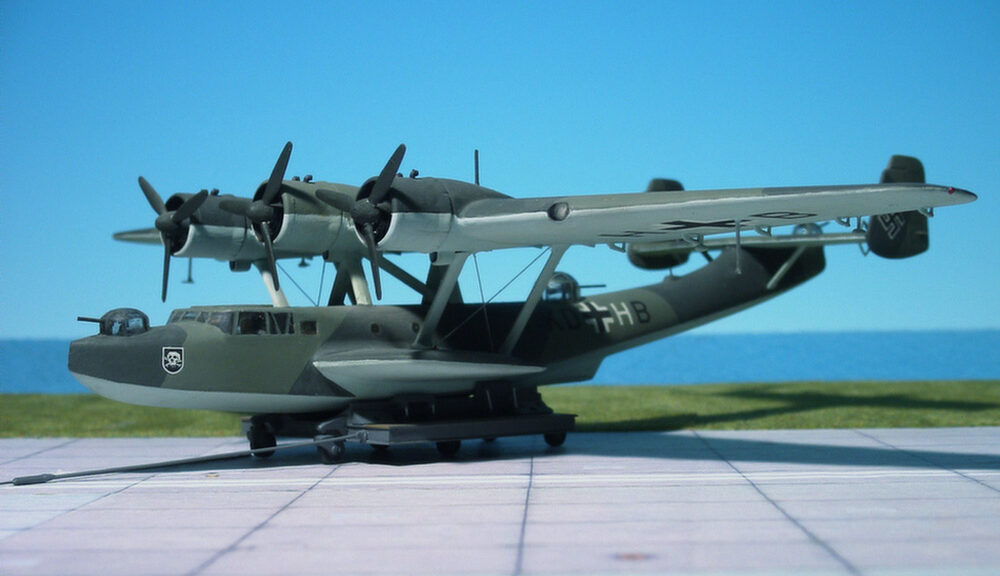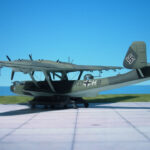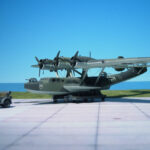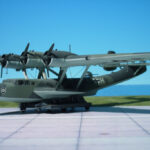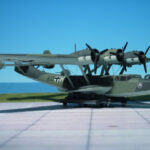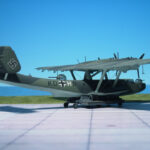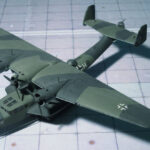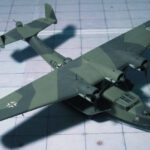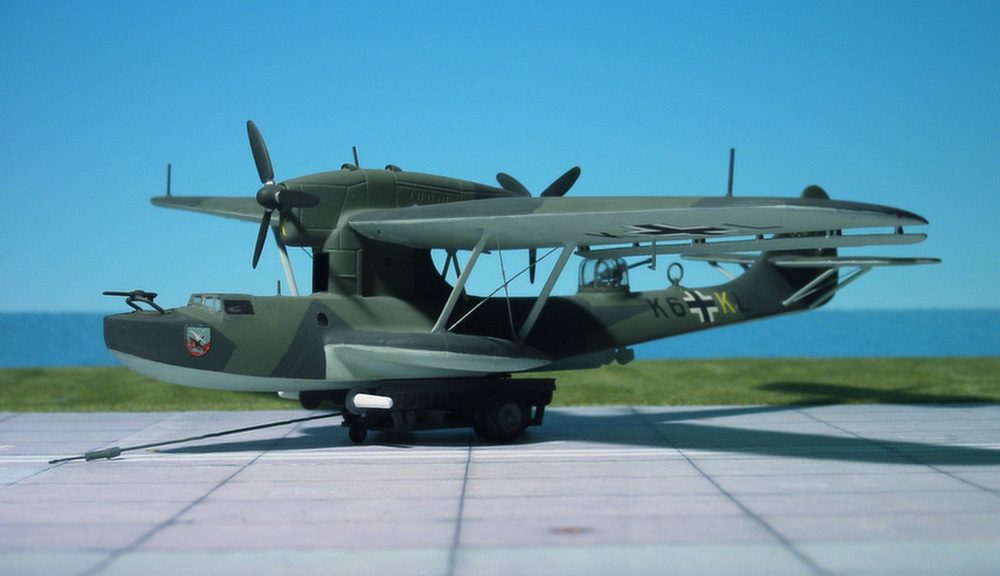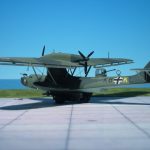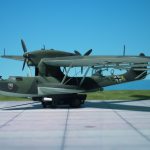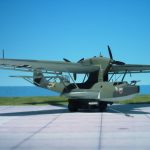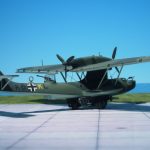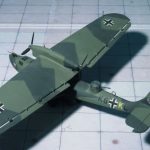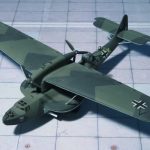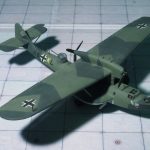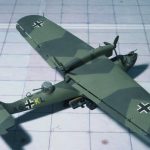Galleries
Focke-Wulf Fw 190C-V18/U1 (Frank-Airmodel)
Bell L-39-1 (IPMS Canada, Resin)
TYPE: Experimental swept-wing aircraft
ACCOMMODATION: Pilot only
POWER PLANT: One Allison V-1710-117 liquid-cooled engine, rated at 1,800 hp
PERFORMANCE: 410 mph at 25,000 ft
COMMENT: Two war surplus Bell P-63C Kingcobra fighter aircraft were modified by Bell under Navy contract for flight testing of low-speed and stall characteristics of high-speed wing designs. The aircraft received new wings with adjustable leading edge slats, trailing edge flaps and a pronounced sweep of 35 degrees. The wings had no wheel wells; only the nose gear was retractable. L-39-1 first flew 23 April 1946, demonstrating a need for extra tail surface and rear fuselage length to balance the aircraft in flight—the wing repositioning reduced empennage effectiveness and moved the center of lift aft. A lighter three-bladed propeller from a Bell P-38Q-10 was mounted and the necessary changes to the empennage were made. L-39-2 incorporated these adjustments from the start. L-39-1 later went to NACA at Langley for wind tunnel testing, where much valuable data were gathered. Bell L-39-2 also served as a testbed for the Bell X-2 40-degree wing design (Ref.: 24).
Bell P-63C Kingcobra (Resin)
TYPE: Fighter
ACCOMMODATION: Pilot only
POWER PLANT: One Allison V-1710-117 liquid-cooled engine, rated at 1,800 hp
PERFORMANCE: 410 mph at 25,000 ft
COMMENT: The Bell P-63 Kingcobra was an American fighter aircraft that was developed by Bell Aircraft during Worlf War II. Based on the preceding Bell P-39 Airacobra, the P-63’s design incorporated suggestions from P-39 pilots and was superior to its predecessor in virtually all respects. The P-63 was not accepted for combat use by the United States Army Air Forces. However, it was used during World War II by the Soviet Air Force which had also been the most prolific user of the P-39.
While the P-39 had originally been introduced as an interceptor, later in its development it was decided to reduce the cost and complexity of the engine by removing the turbocharger. High-altitude performance suffered dramatically as a result, and Bell proposed an experimental series to test out a variety of solutions.
The resulting XP-39E featured two primary changes from the earlier P-39D from which it was developed. One was a redesigned wing. The root airfoil was changed to gain internal volume. The other was a switch to the Continental I-1430 engine, which featured an improved overall design developed from the hyper engine efforts, as well as an improved supercharger.
Three prototypes were ordered in April 1941.The I-1430 was having continued development problems and could not be delivered in time, so it was replaced by an Allison V-1710-47, similar to that powering the P-39. Each prototypes tested different wing and tail configurations. The XP-39E proved faster than standard Airacobra, reaching a maximum speed of 386 at 21,680 ft during tests. However, the XP-39E was considered inferior to the stock P-39 Airacobra in all other respects, so it was not ordered into production.
Although the XP-39E proved disappointing, the USAAF was nevertheless interested in an even larger aircraft based on the same basic layout. Even before its first flight, the USAAF placed an order on 27 June 1941 for two prototypes of an enlarged version powered by the same V-1710-47. The new design was given the designation Bell XP-63 Kingcobra. A third prototype was also ordered, using the Packard V-1650, the U.S.-built version of the Rolls-Royce Merlin engine.
The XP-63 was larger in all dimensions than the Airacobra. The wing was redesigned again, this time with new NACA laminar flow airfoils, wing span increased to 38 ft 4 in, and wing area was increased to248 sq ft. The engine was fitted with a second remotely mounted supercharger, supplementing the normal single-stage supercharger. At higher altitudes, when additional boost was required, a hydraulic clutch would engage the second supercharger, adding 10,000 ft to the service ceiling. A larger four-bladed propeller was also standardized. A persistent complaint against the Airacobra was that its nose armament was not easily accessible for ground maintenance, and in order to cure this problem, the XP-63 airframe was fitted with larger cowling panels.
he first prototype flew for the first time on 7 December 1942. It was destroyed on 28 January 1943 when its landing gear failed to extend. The second prototype followed on 5 February 1943. It, too, was destroyed, this time due to an engine failure. The Merlin-engined prototype was delivered with another Allison instead, an Allison V-1710 -93, which had a war emergency rating of 1,500 hp at sea level, making this prototype one of the fastest Kingcobras built, attaining 421 mph at 24,100 ft.
Deliveries of production P-63As began in October 1943. The USAAF concluded the Kingcobra was inferior to the Mustang, and declined to order larger quantities. American allies, particularly the Soviet Union, had a great need for fighter aircraft, however, and the Soviets were already the largest users of the Airacobra. Therefore, the Kingcobra was ordered into production to be delivered under Lend-Lease.
Soviet input was significant. With the Soviet Union being the largest buyer of the aircraft, Bell was quick to implement their suggestions. The vast majority of the changes in the P-63A sub-variants were a direct result of Soviet input, e.g. increased pilot armor and fuselage hardpoint on the A-5, underwing hardpoints and extra fuel tanks on the A-6, etc. Most significantly, Soviet input resulted in moving the main cannon forward, favorably changing the center of gravity, and increasing its ammo load from 30 to 58 rounds for the A-9 variant. The P-63 had an impressive roll rate, besting the Americans’ Republic P-47, Curtiss P-40, and North American P-51—and the Japanese Navy’s Kawanishi N1K2 Shiden-Kai fighter—with a rate of 110° per second at 275 mph.
In general, official Soviet histories played down the role of Lend-Lease supplied aircraft in favor of local designs, but it is known that the P-63 was a successful fighter aircraft in Soviet service. A common Western misconception is that the Bell fighters were used as ground attack aircraft.
3.303 aircraft had been completed when the assembly lines stopped at the end of WW II (Ref.: 24)
Lockheed “Hudson Mk.V”, RAF, 500rd Squadron (Academy Models)
TYPE: Light bomber, reconnaissance aircraft
ACCOMMODATION: Crew of six
POWER PLANT: Two Pratt & Whitney “Twin Wasp” radial engines, rated at 1,200 hp each
PERFORMANCE: 246 mph
COMMENT: The Lockheed “Hudson” was an American-built light bomber and coastal reconnaissance aircraft built initially for the British Royal Air Force shortly before the outbreak of WW II and primarily operated by the RAF thereafter. The “Hudson” served throughout the war, mainly with Coastal Command but also in transport and training roles as well as delivering agents into occupied France. They were also used extensively with the Royal Canadian Air Force’s anti-submarine squadrons and by the Royal Australian Air Force.
In late 1937 Lockheed sent a cutaway drawing of the Model 14 to various publications, showing the new aircraft as a civilian aircraft and converted to a light bomber. This attracted the interest of various air forces and in 1938, the British Purchasing Commission sought an American maritime patrol aircraft for the United Kingdom to support the Avro “Anson”. On December 1938, Lockheed demonstrated a modified version of the Lockheed Model 14 “Super Electra” commercial airliner, which swiftly went into production as the “Hudson Mk I”.
A total of 350 Mk I and 20 Mk II “Hudsons” were supplied. These had two fixed Browning machine guns in the nose and two more in the Boulton Paul dorsal turret. The Hudson Mk III added one ventral and two beam machine guns and replaced the 1,100 hp Wright “Cyclone” cylinder radials with 1,200 hp versions (428 produced).
The “Hudson Mk V” (309 produced) and Mk VI (450 produced) were powered by the 1,200 hp Pratt & Whitney “Twin Wasp” 14-cylinder two-row radial. The RAF also obtained 380 Mk IIIA and 30 Mk IV “Hudsons” under the Lend-Lease programme.
By February 1939, RAF “Hudsons” began to be delivered, by the start of WW II in September, 78 “Hudsons” were in service. Due to the United States’ neutrality at that time, early series aircraft were flown to the Canada–US border, landed, and then towed on their wheels over the border into Canada by tractors or horse drawn teams, before then being flown to Royal Canadian Air Force (RCAF) airfields where they were then dismantled and “cocooned” for transport as deck cargo, by ship to Liverpool. The “Hudsons” were supplied without the Boulton Paul dorsal turret, which was installed on arrival in the United Kingdom.
Although later outclassed by larger bombers, the Lockheed “Hudson” achieved some significant feats during the first half of the war. Skilled and experienced pilots found that the Hudson had an exceptional maneuverability for a twin-engined aircraft, especially a tight turning circle if either engine was briefly feathered (Ref. 24).
Bristol Blenheim Mk. V, RHAF, 13th Squadron (MPM Models)
TYPE: Light bomber
ACCOMMODATION: Crew of three
POWER PLANT: Two Bristol “Mercury” XXX radial engines, rated at 920 hp
PERFORMANCE: 266 mph at 11,800 ft
COMMENT: In 1940, a new specification, Spec B. 6/40, was issued by the U.K. Air Ministry to redesign the Bristol “Blenheim” Mk. IV. The major changes included the replacement of the “Mercury” XV engines with the uprated “Mercury” XXX engines, a re-designed nose area, extra armor and a new oxygen system. On February 1941, two prototypes were ready for flight at the Bristol factory. One prototype was a three-seat, high-altitude day bomber. This version had a semi-glazed, asymmetrical nose with a rear-facing blister housing two machine guns. The second prototype was a two-seater close-support aircraft, with solid nose containing four more Browning machine guns, initially known as Bristol “Bisley” (after shooting competitions held at Bisley). This latter variant was not required, probably due to the advent of the single-seater close-support fighters then under development such as the Hawker “Typhoon”. A major improvement of the “Blenheim” Mk. V over its earlier predecessors was the new Bristol B. X. upper gun turret, which was fitted with two machine guns. This turret was capable of high-speed traverse and continuous rotation in either direction. The day bomber type went into production and, by June 1943, a total of 940 aircraft had been produced for the RAF. Manufacture of the “Blenheim” Mk. V was undertaken by the firm of Rootes Security Ltd, at their “shadow” factory at Blythe Bridges, Staffordshire. Although the “Blenheim” Mk. V served in North Africa and the Far East until 1943, its lack of success resulted in many aircraft converted to dual-control and being used as trainers and target tugs (Ref.: MPM).
Tokyo Koku Ki-107 (A + V Model, Resin)
TYPE: Monoplane trainer
ACCOMMODATION: Teacher and student pilot
POWER PLANT: One Hitachi Hatsukaze Ha-47 inline piston engine, rated at 110 hp
PERFORMANCE: 122 mph
COMMENT: The Tokyo Koku Ki-107 was a Japanese military training aircraft for the Imperial Japanese Army Air Force. The Ki-107 was a wooden-built low-wing two-seat monoplane with an open cockpit. Powered by a Hitachi Hatsukaze Ha-47 (Ha-11) inline piston engine it first flew in October 1943.The Japanese Army had ordered 450 as primary trainers as replacement for the Kokusai Ki-86 (a license built German Bücker Bü 131 that used the same Ha-47 engine), but production was held up by air raids and only 29 had been delivered by the end of the war (Ref.: 24).
Tachikawa SS-1 (FEresin, Resin)
TYPE: Pressurized research transport aircraft
ACCOMMODATION: Crew of six
POWER PLANT: Two Mitsubishi Ha-102 radial engines, rated at 1,080 hp each
PERFORMANCE: 295 mph at 19,030 ft
COMMENT: In 1938 the Lockheed Aircraft Corporation exported to Japan a total of thirty of their Model 14-38 twin-engined passenger transport. Twenty aircraft were delivered between March and July 1938 to Tachikawa Hikoki K.K. for eventual re-sale to Nihon Koko K.K. (Japan Air Transport Co Ltd) while a further ten aircraft were delivered direct to Nihon Koku K.K. between June and September 1938. Operated by the airline and its successor, Dai Nippon Koku, on its routes linking Japan to China, the aircraft was powered by a pair of 900 hp Wright R-1820-G3B radials. Being used throughout the war, these civilian aircraft received the Allied code name of TOBY.
Tachikawa, also having successfully negotiated a manufacturing licence with Lockheed, decided to submit to the Army a proposal covering Japanese production of a modified version. As the Army urgently required air transport to support their operations in China, this proposal was favourably received, and in 1939 Tachikawa were instructed to undertake the manufacture of this aircraft to carry military personal. Powered by two 900 hp Mitsubishi Ha-26-I radials and designated Army Type LO Transport, these aircraft were also built by Kawasaki. As the aircraft’s handling characteristics were found somewhat unsatisfactory by Army pilots, Kawasaki were instructed to redesign the aircraft, and eventually this led to the production of the Kawasaki Ki-56. Despite its shortcomings, the Army Type LO Transport, known as THELMA to Allied forces, was operated until the Japanese surrender.
In late 1940, Tachikawa undertook to produce an experimental aircraft specifically for pressurization experiments. To speed up work, the wings, rear fuselage section and tail surfaces of the Army Type LO Transport were retained, and a shorter pressurized forward and centre fuselage section was designed. Of cylindrical cross section, the new forward fuselage had no windscreen step, and other modifications included the replacement of the Type LO power plants with two 1,080 hp Mitsubishi Ha-102 radials. Designated Tachikawa SS-1, the aircraft was completed in May 1943 and during its brief trials proved valuable data on cabin pressurization (Ref.: 1).
Dornier Do 24T-1 (Revell)
TYPE: Maritime reconnaissance and transport flying boat
ACCOMMODATION: Crew of six
POWER PLANT: Three Bramo 323R-2 Fafnir radial engines, rated at 1,200 hp with water injection each
PERFORMANCE: 211 mph at 15,750 ft
COMMENT: The Dornier Do 24 is a 1930s German three-engine flying boat designed by the Dornier Flugzeugwerke for
maritime patrol and search rescue. According to Dornier records, some 12,000 people were rescued by Do 24s during its flying career. A total of 279 were built among several factories from 1937 to 1945.
The Dornier Do 24 was designed to meet a Royal Netherlands Navy requirement for a replacement of the Dornier Wals (Do 16) being used in the Dutch East Indies, with the Netherlands government signing a contract for six Dornier Do 24s on August 1936. Two more prototypes were built for the German navy to be evaluated against the Blohm & Voss Bv 138.
The Do 24 was an all-metal parasol monoplane with a broad-beamed hull and stabilising sponsons. Twin tails were mounted on the upswept rear of the hull, while three wing-mounted tractor configuration engines powered the aircraft. Fuel was carried in tanks in the sponsons and the wing centre section. Up to 1,200 kg of bombs could be carried under the aircraft’s wings, while defensive armament consisted of three gun turrets, one each in nose, dorsal and tail positions. In early aircraft the turrets were each fitted with a machine gun but later aircraft carried a 20 mm cannon in the dorsal turret.
The Do 24 V3, the first of the Dutch boats, took off from Lanke Constance on July 1937, with the second Dutch boat, Do 24 V4 following soon after.
The Netherlands was enthusiastic about the new flying boat and planned to purchase as many as 90. Of these, 30 were to be built by Dornier (with all but the first two prototypes assembled by Dornier’s Swiss subsidiary based at Altenheim. The remaining aircraft were to be built under licence in the Netherlands by Aviolanda at Papendrecht. Of these aircraft, all but one of the German and Swiss built aircraft and the first seven Aviolanda-built aircraft were to be Do 24K-1s, powered by the original Wright R-1820-F52 cyclone 9 engines, while the remaining aircraft were to be Do 24K-2s, with more powerful 1,100 hp Wright R-1820-G102 engines and more fuel.
Only 25 aircraft had been built on the Aviolanda assembly line before the German occupation. The Luftwaffe were interested in the completed and partially completed aircraft. The Dutch production line continued to produce aircraft under German control. 11 airframes were completed with Dutch-bought Wright Cyclone engines but later models used the BMW Bramo 323R-2. A further 159 Do 24s were built in the Netherlands during the occupation, most under the designation Do 24T-1.
Another production line for the Do 24 was established in the old CAMS factory at Sartrouville, France, during the German occupation. This line was operated by SNCAN and was able to produce another 48 Do 24s. After the liberation, this facility produced a further 40 Do 24s, which served with the French Navy until 1952.
Thirty-seven Dutch- and German-built Do 24s had been sent to the East Indies by the time of the German occupation of the Netherlands in June 1940. Until the outbreak of war, these aircraft would have flown the tri-color roundel. Later, to avoid confusion with British or French roundels, Dutch aircraft flew a black-bordered orange triangle insignia.
After the Japanese invasion of the Netherlands East Indies, six surviving Do 24s were transferred to the Royal Australian Air Force in February 1942. They served in the RAAF through most of 1944 as transports in New Guinea.
In 1944, 12 Dutch-built Do 24s were delivered to Spain with the understanding that they would assist downed airmen of both sides. After the war, a few French-built Do 24s also found their way to Spain. Spanish Do 24s were operational at least until 1967, and possibly later. In 1971, one of the last flying Spanish Do 24s was returned to the Dornier facility on Lake Constance for permanent display (Ref.:24).
Dornier Do 18G-1 (Matchbox)
TYPE: Patrol and reconnaissance flying boat
ACCOMMODATION: Crew of four
POWER PLANT: Two Junkers Jumo 205C-4 liquid-cooled diesel engines, rated at 605 hp each
PERFORMANCE: 155 mph at sea level
COMMENT: In 1934, the Dornier Flugzeugwerke started development of a new twin-engined flying boat to replace the Dornier Do J “Wal“ (Whale) in both military (Do 16) and civil (Do JI and Do J II) roles. The resultant design, Do 18 retained the layout of the “Wal”, with a metal hull fitted with distinctive stabilizing sponsons, and powered by two engines above the wing in a push-pull layout, but was aerodynamically and hydrodynamically more efficient. It was planned to be powered by two of the new Junkers Jumo 205 diesel engines. Although heavy, these promised to give much lower fuel consumption than conventional petrol engines of similar power.
The Do 18G, 62 units built, was an improved version, powered by two 880 hp Jumo 205D engines, armed with a 13 mm MG machine gun in the bow, and a 20 mm MG 151 cannon in a power-operated dorsal turret.
In German Luftwaffe service, the Dornier Do 18G was obsolete by the outbreak of World War II, but – as the only military flying boat – 62 (58 serviceable) aircraft in five squadrons were in use mainly on North Sea reconnaissance missions. In 1940 some squadrons changed their base to Norway. The vulnerable and underpowered flying boat was soon relegated to training and the air/sea rescue role. In the middle of 1941, only one squadron was still operational on Do 18. The Blohm & Voss Bv 138 had superseded the Dornier Do 18G.
A Dornier Do 18G was the first German aircraft to be shot down by British aircraft during the war, when one of a formation of three was caught over the North Sea by nine Fleet Air Arm Blackburn “Skua” fighter bombers of 803 Naval Air Squadron flying from HMS “Ark Royal” on 26 September 1939 (Ref.: 24).
